|
||||||||||||||||||||||
![Home - Air Power Australia Website [Click for more ...]](APA/APA-Title-Main.png) |
||||||||||||||||||||||
![Sukhoi PAK-FA and Flanker Index Page [Click for more ...]](APA/flanker.png) |
![F-35 Joint Strike Fighter Index Page [Click for more ...]](APA/jsf.png) |
![Weapons Technology Index Page [Click for more ...]](APA/weps.png) |
![News and Media Related Material Index Page [Click for more ...]](APA/media.png) |
|||||||||||||||||||
![Surface to Air Missile Systems / Integrated Air Defence Systems Index Page [Click for more ...]](APA/sams-iads.png) |
![Ballistic Missiles and Missile Defence Page [Click for more ...]](APA/msls-bmd.png) |
![Air Power and National Military Strategy Index Page [Click for more ...]](APA/strategy.png) |
![Military Aviation Historical Topics Index Page [Click for more ...]](APA/history.png)
|
![Intelligence, Surveillance and Reconnaissance and Network Centric Warfare Index Page [Click for more ...]](APA/isr-ncw.png) |
![Information Warfare / Operations and Electronic Warfare Index Page [Click for more ...]](APA/iw.png) |
![Systems and Basic Technology Index Page [Click for more ...]](APA/technology.png) |
![Related Links Index Page [Click for more ...]](APA/links.png) |
|||||||||||||||
![Homepage of Australia's First Online Journal Covering Air Power Issues (ISSN 1832-2433) [Click for more ...]](APA/apa-analyses.png) |
||||||||||||||||||||||
| Last Updated: Mon Jan 27 11:18:09 UTC 2014 | ||||||||||||||||||||||
|
||||||||||||||||||||||
|
||||||||||||||||||||||
![Home - Air Power Australia Website [Click for more ...]](APA/APA-Title-Main.png) |
||||||||||||||||||||||
![Sukhoi PAK-FA and Flanker Index Page [Click for more ...]](APA/flanker.png) |
![F-35 Joint Strike Fighter Index Page [Click for more ...]](APA/jsf.png) |
![Weapons Technology Index Page [Click for more ...]](APA/weps.png) |
![News and Media Related Material Index Page [Click for more ...]](APA/media.png) |
|||||||||||||||||||
![Surface to Air Missile Systems / Integrated Air Defence Systems Index Page [Click for more ...]](APA/sams-iads.png) |
![Ballistic Missiles and Missile Defence Page [Click for more ...]](APA/msls-bmd.png) |
![Air Power and National Military Strategy Index Page [Click for more ...]](APA/strategy.png) |
![Military Aviation Historical Topics Index Page [Click for more ...]](APA/history.png)
|
![Intelligence, Surveillance and Reconnaissance and Network Centric Warfare Index Page [Click for more ...]](APA/isr-ncw.png) |
![Information Warfare / Operations and Electronic Warfare Index Page [Click for more ...]](APA/iw.png) |
![Systems and Basic Technology Index Page [Click for more ...]](APA/technology.png) |
![Related Links Index Page [Click for more ...]](APA/links.png) |
|||||||||||||||
![Homepage of Australia's First Online Journal Covering Air Power Issues (ISSN 1832-2433) [Click for more ...]](APA/apa-analyses.png) |
||||||||||||||||||||||
| Last Updated: Mon Jan 27 11:18:09 UTC 2014 | ||||||||||||||||||||||
|
||||||||||||||||||||||
| The
Sidewinder
Story The Evolution of the AIM-9 Missile |
||||||||||||||||||||||||||||||||||||||||||||||||||||||||||||||||||||||||||||||||||||||||||||||||||||||||||||||||||||||||||||||||||||||||||||||||||||||||||||||||||||||||||||||||||||||||||||||||||||||||||||||||||||||||||||||||||||||||||||||||||||||||||||
|
||||||||||||||||||||||||||||||||||||||||||||||||||||||||||||||||||||||||||||||||||||||||||||||||||||||||||||||||||||||||||||||||||||||||||||||||||||||||||||||||||||||||||||||||||||||||||||||||||||||||||||||||||||||||||||||||||||||||||||||||||||||||||||
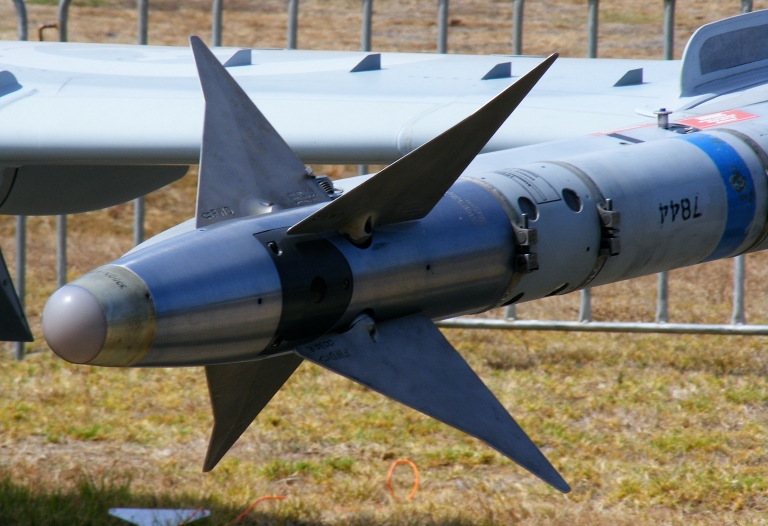 The AIM-9L/M seeker used the aerodynamic design of the AIM-9H with a new all aspect InSb based detector . The example is carried by an RAAF Hawk (© 2009 Dr Carlo Kopp; Fuji S5600). The ubiquitous AIM-9 Sidewinder is without doubt the most important heatseeking missile of the last three decades, seeing service in every engagement between Western powers and their adversaries since the 1950s. Shamelessly copied by the Communists as the K-13/AA-2 Atoll, the Sidewinder has had a profound influence on the design of modern heatseekers and is much the yardstick against which such missiles are judged today. The collapse of the agreement between the US and EEC nations on the ASRAAM, the planned successor to the AIM-9, has seen further life injected into the humble Sidewinder, with the US at the time of writing electing to continue the development and production of the weapon for its own services. The AIM-9 has had a colourful history and has evolved considerably since the first of its kind left a missile rail in the distant fifties. It is story of technical ingenuity as much as operational application and more than anything underscores the fundamental soundness of the basic airframe and system design, which has seen ongoing evolutionary development since the fifties. The Beginning - the AIM-9B The AIM-9 traces its earliest ancestry to the US Naval Weapons Center at China Lake, in the Mojave Desert. THe NWC initiated, in the early fifties, a program to design a heatseeking air intercept missile for the intercept of bombers by naval interceptor aircraft, until then armed with either .50 cal or 20 mm guns. The fledgling missile was aptly named after the Sidewinder, a desert rattlesnake which detects its prey by sensing the animal's heat emissions. The result was a compact lightweight cruciform canard weapon, which used a solid propellant rocket motor, a fragmentation warhead and an uncooled optical seeker. The Sidewinder's seeker used an ingeniously clever optical arrangement, with a Cassegrainian mirror fitted with a tilted secondary mirror. The secondary mirror rotated in unison with a reticle, projecting the whole instantaneous field of view of the mirror through the reticle onto a filter/detector assembly. Because the mirror secondary was tilted, rotating it about the missile's axis swept the cone of the mirror's field of view about the missile's axis in a fashion analogous to a conical scanning radar seeker (see diagram). The missile used a 2.5" glass dome nose window, transparent to 1 micron band radiation, providing with the gimballed seeker for a 25 degree seeker field of view. The mirror assembly provided a 4 degree instantaneous field of view (IFOV), projected on to a PbS (Lead Sulphide) uncooled detector. Because of the design of the optical system, the AIM-9B was strictly a tail aspect weapon, as it was blind to anything cooler than a tailpipe. The modest 11 deg/sec seeker tracking rate limited the weapon to non-maneuvering targets. All seeker electronics were built from vacuum tubes. A hot gas generator provided actuator power for the nose canards, and was limited to a 20 sec burn duration before exhaustion. Unlike other missiles of the day, the Sidewinder did not employ active roll stabilisation (via gyros and differential control input), instead employing rollerons, ie slipstream spun metal discs embedded in the trailing edge of the wingtips, which acted as four tiny gyros stabilising the missile mechanically. The engineer who thought of that certainly earned his paycheck. 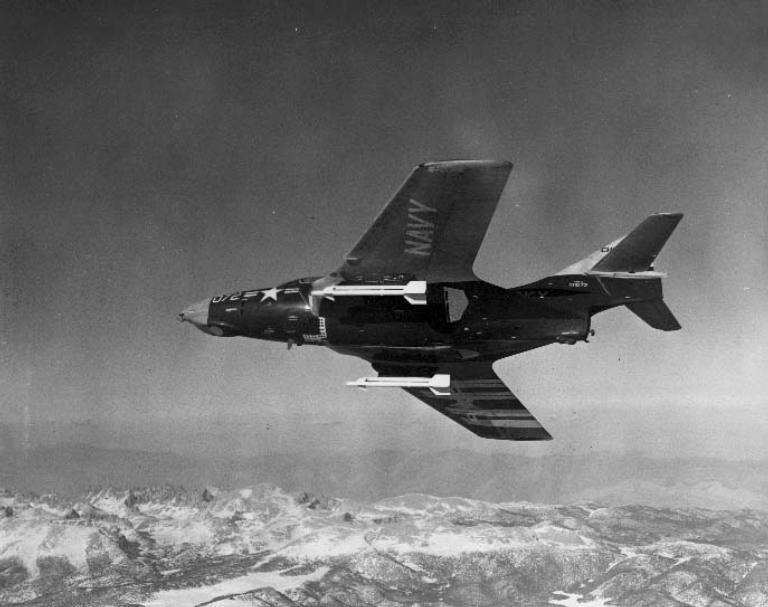 The AIM-9B used a fragmentation warhead triggered by a passive infrared proximity fuse. The Thiokol Mk.17 solid propellant rocket delivered 8,200 lb-sec of impulse with a burn duration of 2.2 seconds. While by modern standards the AIM-9B is a very limited weapon, it had no serious competitors in its day and was soon adopted by the USAF and NATO as a standard weapon, with no less than 40,000 guidance units built by Ford Aerospace, the prime contractor. The RAAF also adopted the missile, fitting it to the CAC Avon-Sabre, and subsequently the Mirage. NATO rounds were mainly built by West Germany's FGW, who evolved an improved subtype designated the AIM-9B-FGW Mod.2. This AIM-9B used solid state electronics, carbon dioxide seeker cooling, a new nose dome and better optical filtering, the latter providing for much better seeker sensitivity. 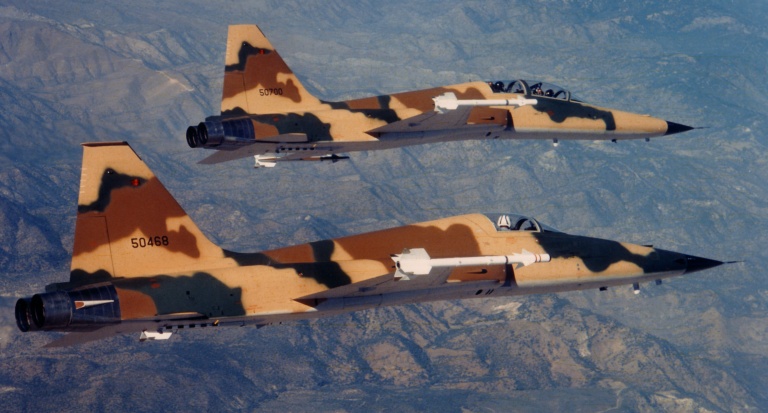 The Sidewinder was by the early sixties the principal heatseeker in Western service and as such first drew blood over North Vietnam, there used by the USAF and USN. Its early combat record was not spectacular, as the seeker performance limitations were exacerbated by the poor reliability of the tube electronics and the inexperience of its users, who until then trained for intercepts rather than dogfights. Kill probabilities were in the tens of percent, very sensitive to how well the launch aircraft was positioned. Designed to intercept lumbering bombers, the AIM-9B was ill suited to knife-fights with MiG-17s at low level. Its launch load factor limit of 2G hampered aircrew, while its seeker very often locked on to the sun or clouds, subsequently sending the missile ballistic. The range limit of 2.6 NM meant that the launch aircraft had to be quite properly positioned for a shot, and the pilot very careful about closure rate and range. Nevertheless, no less than 28 MiGs were killed for 175 launches between 1965 and 1968, by USAF F-4C/D aircraft, an aggregate P[k] (kill probability) of 16%. The Navy Sidewinders - AIM-9D, G and H The US Navy recognised the limitations of the AIM-9B during the early fifties, and soon proceeded with the development of a follow-on subtype with improved performance. Thus was born the first of a series of dedicated naval Sidewinders, a split in the family tree which persists to this very day. The most important change in the AIM-9D was the use of a Nitrogen cooling system for the PbS detector element, coupled to a redesigned optical system. The new optical system retained the tilted cassegrain of the earlier subtype, but was more compact, fitting into a ogival nose section, and spun at a higher frequency of 125 Hz, rather than the 70 Hz of the B-model. The IFOV was reduced to 2.5 degrees, while the seeker FOV was slightly increased to beyond 25 degrees. The glass nose dome was replaced by a much smaller Magnesium Fluoride dome, which provides better transparency to longer wavelength (cooler) infrared emissions. The Nitrogen coolant was contained in a 6 litre bottle in the Navy LAU-7 launcher, and provided for 2.5 hrs of seeker cool down. The seeker changes provided a higher target tracking rate of 12 deg/sec, and this was further assisted by an improved actuator system, which delivered up to 100 lb.ft of torque. Both of these measures improved missile manoeuvrability, while a longer gas generator burn provided for a 60 second usable flight time. The rocket motor was changed to a Hercules Mk.36, with more impulse and longer burn. Changes were also introduced to the fusing, with the option of an infrared fuse or a radio-frequency proximity fuse, which fired a new continuous rod warhead. Continuous rod warheads have a casing of lengthwise rods welded together at alternate ends, on detonation the rods expand into a circle about the missile before breakup, upon which a torus of fragments is produced about the axis of the weapon. These rods are like knives which chop into the skin and structure of the target. In comparison with the AIM-9B, the AIM-9D had a much wider engagement envelope, was more manoeuvrable and hence offered a better P[k]. The AIM-9D entered production in the late fifties, and Ford Aerospace built about 1,000 systems. 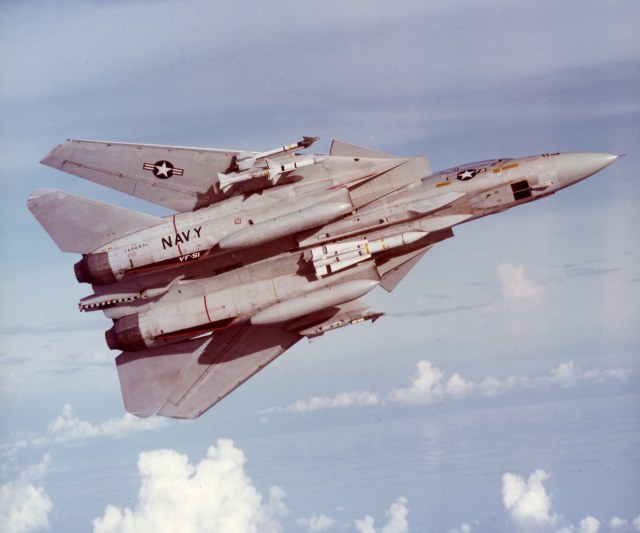 The AIM-9D was succeeded by the very similar AIM-9G, which employed SEAM (Sidewinder Extended Acquisition Mode), a facility which slews the optics through a search pattern to acquire the target (most likely using a rosette scan), or allows slaving of the optics to radar or a helmet sight. The latter was used extensively by Navy F-4s during the seventies, before the deployment of the F/A-18. The AIM-9D/G was used extensively by the Navy in Vietnam, accounting for many kills of manoeuvrable adversaries such as the nimble MiG-17 and MiG-19, engaging Navy aircraft at low altitude. Most Navy kills were scored with this weapon. The latter phase of the Vietnam war, the Linebacker campaigns, saw the first application of the subsequent naval Sidewinder, the AIM-9H. The Hotel saw some radical changes resulting from experience with the D/G, which suffered reliability problems due the intolerance of vacuum tubes to repeated 20 ft/sec sink rate recoveries on aircraft carrier decks. The AIM-9H was the first solid state Sidewinder, with the complete guidance package built with semiconductors. In redesigning the electronics, the G optical system was essentially retained, but the tracking rate was further increased, to complement the more powerful 120 lb.ft actuators. While few of the AIM-9H were fired in combat due shortages of supply, they are reported to have scored a much higher kill rate per launch than any other Sidewinder in the campaign. Over 3,000 were built. The AIM-9H was by far the best of the early Sidewinders and distinguished itself in Vietnam achieving the best kill rate of any missile in the campaign. Using a solid state seeker with a Nitrogen cooled Lead Sulphide detector, and a more powerful actuator system, the AIM-9H was the most manoeuvrable of its kind. The subsequent AIM-9L was directly derived from the AIM-9H. The Air Force Sidewinders - AIM-9E, J and N Unlike the USN which was focussed on the tactical air battle, the USAF had diluted its resources into several AAM programs and thus lagged in the development of their own Sidewinder subtypes. Vietnam saw the AIM-9B perform questionably, and the USAF sought improvements to the design to enhance performance against fighter type targets. The result was the AIM-9E. 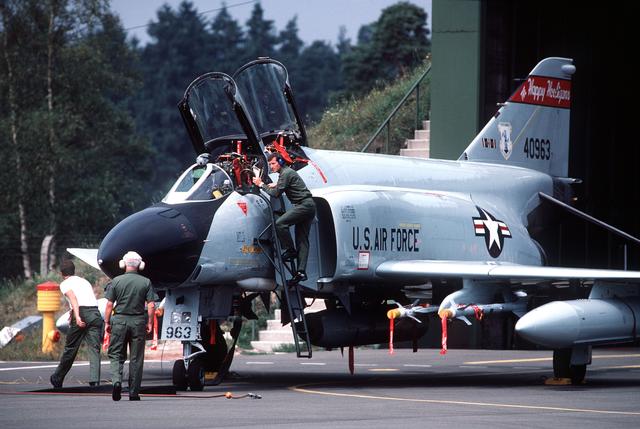 The AIM-9E saw the adoption of a similar low drag nose to the Navy subtypes, but using a conical rather than ogival profile, a distinguishing feature of this family to this very day. A Magnesium Fluoride dome was adopted, a more compact optical assembly was used, with a faster 100 Hz reticle rate, and a 16.5 deg/sec tracking rate. The canards were changed to the characteristic squared tip double delta planform, adopted to improve canard behaviour at higher angles of attack. Significant changes were made to the internal wiring harnesses. The most significant design change was the adoption of a cooling for the PbS detector element, the USAF opting for Peltier thermoelectric cooling. This arrangement has the advantage of unlimited cooling time on the launch rail, subject only to the availability of electrical power. The seeker improvements expanded the weapon's acquisition envelope and increased its P[k], although not dramatically. Over 5,000 rounds were rebuilt from AIM-9Bs. The AIM-9E was deployed to SEA in the late sixties, and saw considerable use by the USAF. Because most USAF engagements were flown at higher altitudes, the weapon was used far less often than the Sparrow, and at short ranges the USAF F-4E nd F-105D/F/G tended to rely on the internal M-61 gun, therefore the AIM-9 accounted for only 14% of USAF kills. Arguably this environment produced less pressure for improvements in USAF AIM-9 performance, resulting in the use of less capable versions in comparison with the Navy, whose F-4Bs were armed solely with missiles. An interesting idiosyncrasy of the Vietnam period Sidewinders was how they killed their targets, as they invariably pursued their targets and in most instances flew up the tailpipe, bisecting the MiG aft of the wing upon warhead detonation. Much interesting gun camera footage exists. 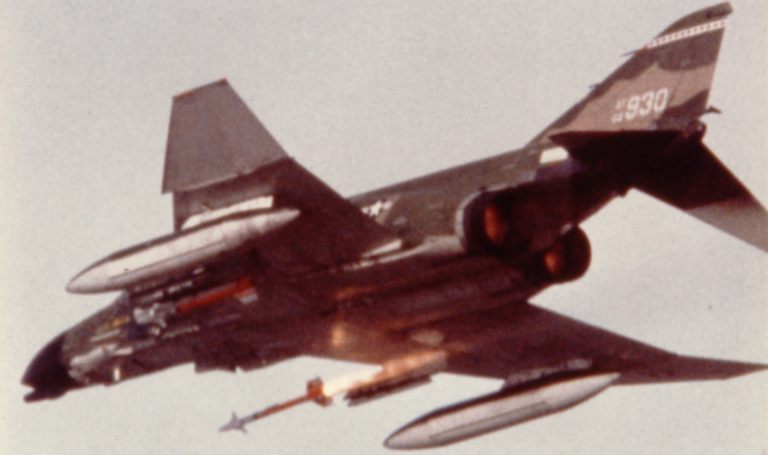 AIM-9J launch from US Air Force
F-4D Phantom (US Air Force image).
The follow-on version to the AIM-9E was the AIM-9J, which was rushed into the SEA theatre in July, 1972. The Juliet model saw incremental improvements to the AIM-9E design, with hybrid electronics using a mix of solid state and tube technology, and an improved control system using a longer burning gas generator for a 40 sec flight time, and more powerful actuators delivering 90 lb.ft torque to the canards. 6,700 of this subtype were eventually built or rebuilt from AIM-9Bs. In 1973, Ford began production of an enhanced AIM-9J-1, later redesignated the AIM-9N. The November model employed a similar configuration to the Juliet, but the three main printed circuit boards were substantially redesigned to improve seeker performance. Close to 7,000 of this version were built. The Hercules-Aerojet Mk.17 rocket motor was retained.
Author's note: This table was compiled from a wide range of sources, many of which do not specify the exact conditions under which the stated performance figures apply. Therefore caution must be exercised in interpreting the figures. Since newer variants are still current in service, detailed figures for these are hard to acquire. The All Aspect Sidewinders - AIM-9L and M The lessons of Vietnam and the Yom Kippur clearly indicated the limitations of the established Sidewinder subtypes, which did not perform well at low altitudes due background infrared emitted by the earth's surface and reflected by clouds, and were limited to tail hemisphere engagements due to the spectral range of the PbS detector element used. The need for all aspect capability against agile targets dictated changes in both detector material and proximity fuse, as the passive IR fuses used to date relied on sensing the target's exhaust at close range. Much debate took place in the mid-seventies as to the successor to the Sidewinder, with a USN proposal for a modified AIM-9H eventually adopted as offering the lowest risk. A West German proposal to fit a fully gimballed seeker to the AIM-9H airframe, creating the ALASCA (all aspect capability) missile was dropped. 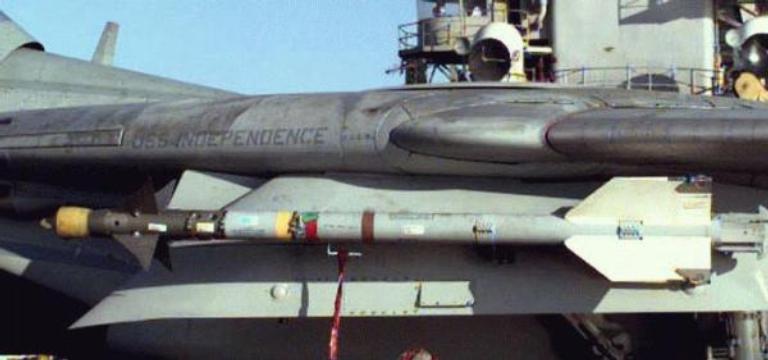 The AIM-9L is essentially an AIM-9H with a new optical system, new fuse and new cooling system. The Cassegrain system of the H was retained, but a new FM reticle was adopted, necessitating some fundamental changes to the guidance electronics. A new 4 micron band Indium Antimonide (InSb) detector was used, enclosed with an optical filter in a cryogenic container. This optical system allows acquisition and tracking of targets from all aspects, due the longer wavelength sensitivity of the InSb, with the filter employed to reject shorter wavelengths. Argon gas is used to cool the detector, with the coolant tank embedded in the missile's seeker to allow use with arbitrary physically/electrically compatible launchers. The FM reticle provides superior performance by reducing the effect of a target's increasing size with decreasing range on the seeker error signal output, a factor which can affect the behaviour of AM seekers, while providing the potential for better countermeasures rejection. In addition, design changes were adopted to bridge the dead zone about the missile's immediate boresight, a characteristic of conventional reticle seekers. To widen the manoeuvre envelope, lambda compensation is employed, a technique which prevents the seeker from reaching its angular limit during the early phase of its flight. If a target can force the seeker past its angular limit, lock is broken and the missile lost. The control actuators of the AIM-9H were retained, but the canards were redesigned to the characteristic pointed tip double delta. The combination of new seeker and canards results in much better manoeuvre performance than any earlier subtype, while the new detector allows acquisition of targets from any aspect at substantially greater ranges. 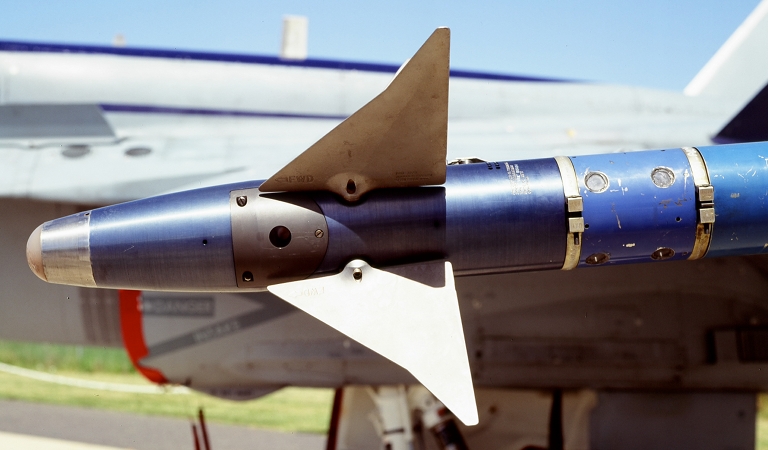 This 3SQN RAAF F/A-18 is armed with an AIM-9L, the first all aspect Sidewinder to be deployed. The AIM-9L was a key factor in the Royal Navy's Falklands success, achieving a kill probability in excess of 80% per launch. The AIM-9L uses the optical system of the AIM-9H, modified for an FM reticle and fitted with an Argon cooled Indium Antimonide detector element. With modified canards to enhance the manoeuvrability of the AIM-9H airframe, and an active laser fuse and annular blast warhead, the AIM-9L was a highly effective dogfight missile (© 1995 Dr Carlo Kopp; M645/1000S with Sekor C 80 mm f2.8). 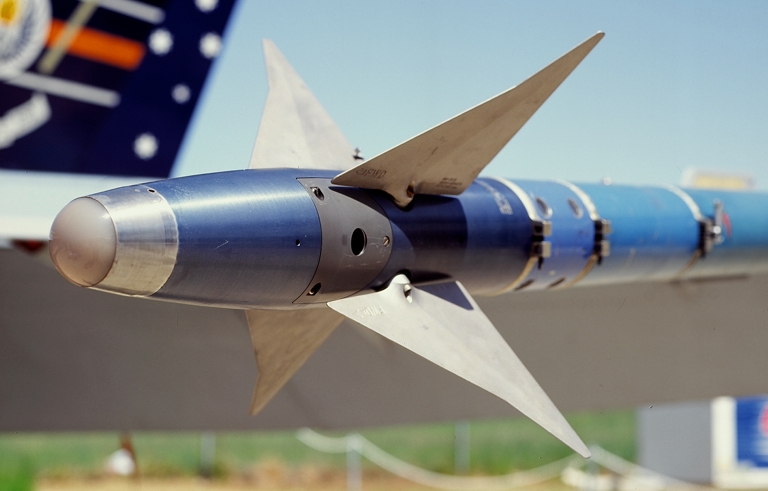 The need to engage dogfight targets required a better fuse and warhead. The AIM-9L was the first subtype to introduce an active laser proximity fuse, the DSU-15A/B. This device uses a group of Gallium Arsenide (GaAs) solid state lasers which radiate a spoke-like pattern about the missile, each laser is paired to a Silicon (Si) photodiode. The lasers emit a stream of pulses, which are reflected by an object which enters the fuse pattern, and sensed by the photodiodes, triggering warhead detonation. The scheme is highly resistant to jamming. 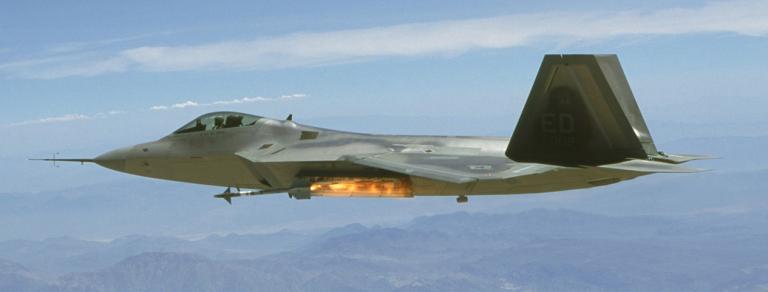 The warhead is also more lethal, using an annular blast arrangement with two layers of rods, which are specifically designed to tumble at high speed to ensure that their effectiveness is not reduced by impact angle on the target, a limitation of the conventional continuous rod scheme. The Lima entered service in the late seventies and first drew blood in 1982, used in both the Falklands campaign and the Bekaa Valley air battle. In both campaigns the weapon was a star performer, achieving kill probabilities in excess of 80%. Royal Navy Harriers and Israeli F-15s slaughtered their opponents in head-on shootouts, the hapless Argentines and Syrians never devising suitable evasive manoeuvres. Over 5,500 rounds were built and were sold only to trusted allies, with licenced production by Bodenseewerk in Germany and Mitsubishi in Japan. 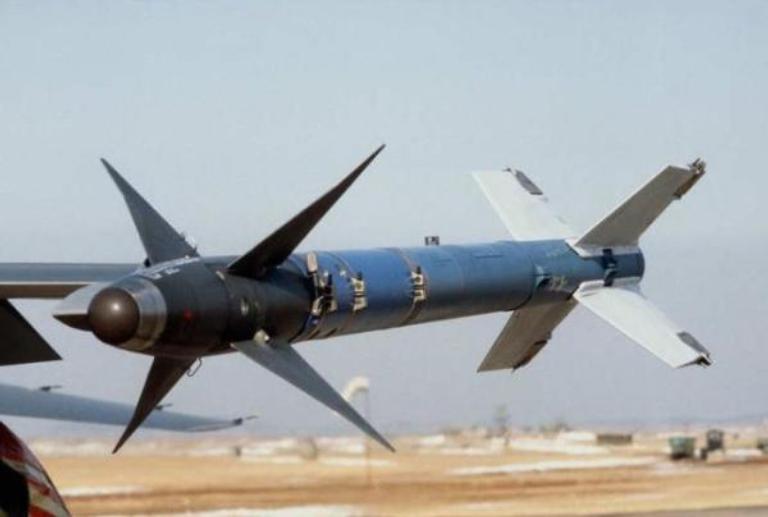 The AIM-9M is an improved AIM-9L, with a low smoke motor, better guidance and counter-countermeasures capability. The AIM-9M is the principal dogfight missile used by frontline Western air forces, and also equips the FAF's F/A-18 force. The AIM-9M was responsible for all of the 10 Sidewinder kills scored during the Gulf conflict, with most kills scored by the longer ranging Sparrow due the Iraqis' reluctance to engage in dogfights. The Lima was followed in production in 1982 by the AIM-9M, which is essentially an improved AIM-9L. The Mike has improved background rejection, counter-countermeasures capability and a low smoke motor to reduce the visual signature of the inbound weapon. The latest subtypes due for deployment are the AIM-9M-8 (Navy) and AIM-9M-9 (USAF). The AIM-9M is the RAAF's standard dogfight AAM, carried by the F/A-18 and F-111. The AIM-9M was deployed in large numbers during last year's Gulf war, but only several kills were achieved as the Iraqi air force preferred to let itself be taken out with six o'clock Sparrow shots. Were they to have done the proper thing and put up a serious fight, the the statistics may have been different, albeit the eventual outcome identical. 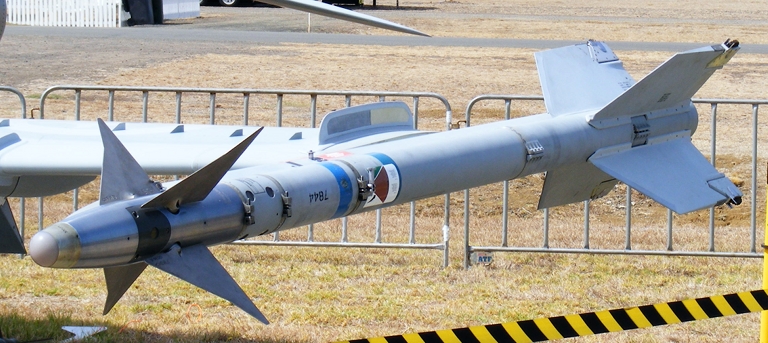 The AIM-9L/M seeker used the
aerodynamic design of the AIM-9H with a new all aspect InSb based
detector. This example is carried by an RAAF Hawk (© 2009 Dr Carlo
Kopp; Fuji S5600).
The Export Sidewinders - AIM-9P While the AIM-9L fulfilled the role of the frontline all aspect dogfight missile, a need still existed for a second tier weapon for use in less demanding situations, and also suitable for export to less than absolutely trusted allies. This requirement was fulfilled by the AIM-9P family, derivatives of the AIM-9J/N. 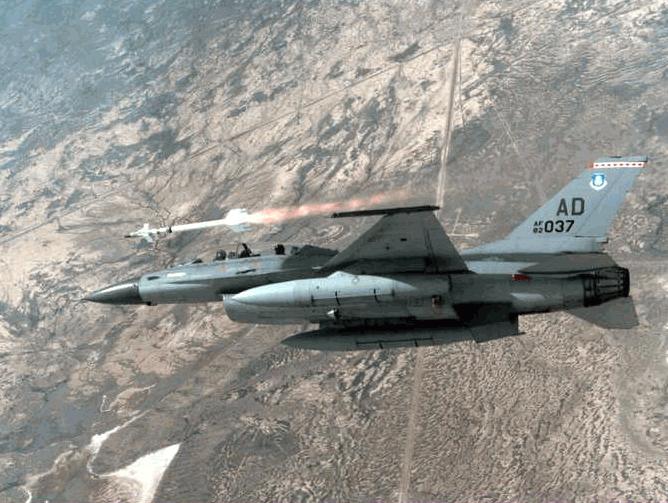 The AIM-9P-2 and P-3 were introduced in the mid seventies and use improved guidance electronics, a new rocket motor and an active optical fuse. While not receiving the publicity of the AIM-9L, the success of the weapon is testified to by the fact that no less than 21,000 have been built, with substantial numbers in the USAF inventory. 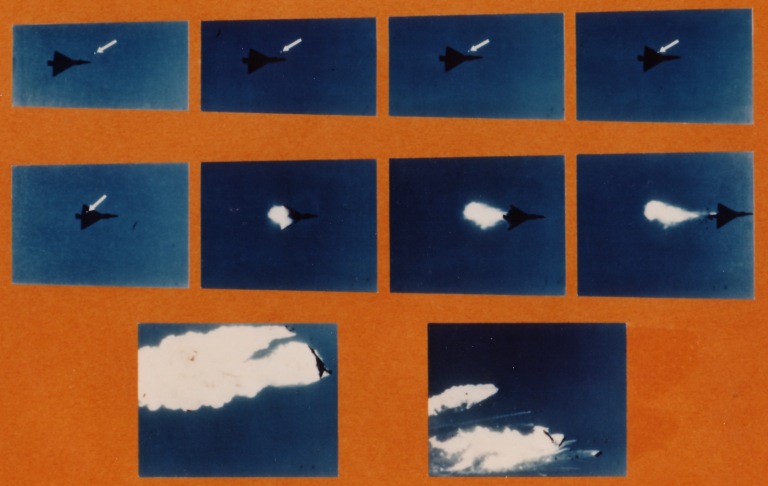 AIM-9P-4 engages a QF-102A
drone
(US Air Force).
The AIM-9P is a USAF sponsored development of the AIM-9J/N family, to provide a missile for use in less demanding applications. The AIM-9P has evolved through the P-2, P-3 to the all aspect P-4, and the P-5 with additional counter-countermeasures capability. Large numbers of various AIM-9P subtypes are in use with the USAF and many export customers. The missile retains the conical nosecone and characteristic double delta canards first used in the Vietnam era USAF AIM-9E. 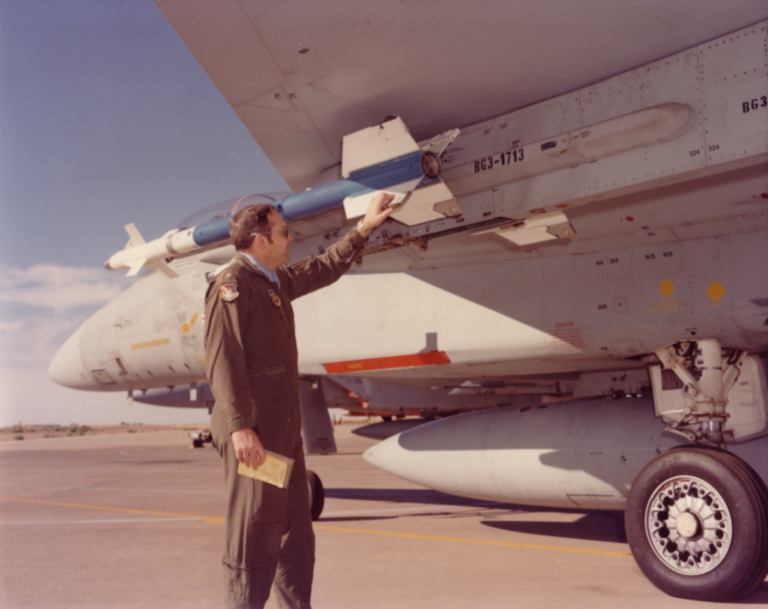 AIM-9P-3
on
F-15 Eagle (US Air Force)
The AIM-9P-4 is an incremental development of the AIM-9P-3, with an all aspect seeker using some of the technology developed for the AIM-9L. In comparison with its cousin, it is less agile but still a very effective missile. The AIM-9P-5 is further improved by the addition of a counter-countermeasures capability. The wide range of types which can carry the P-3/4/5 suggest that the gas coolant is carried on board, as with the L/M. The Radar Homing Sidewinders - AIM-9C and AGM-122A The Sidewinder family has spawned but one radar guided subtype, the US Navy AIM-9C semi-active radar homing missile. This weapon was designed to arm the lightweight F-8 Crusader with an all weather missile, and used a conically scanning semi-active seeker. No records exist as to the missile's combat record and it was all but forgotten until the mid eighties, when stocks of several hundred rounds were resurrected from storage to fulfill a Marine Corps requirement for a lightweight Anti-Radiation Missile for suppression of air defences. The AGM-122A Sidearm is essentially a rebuilt AIM-9C, in which the narrow band semi-active seeker electronics have been modified for the much greater bandwidth required to home in on a wide range of radars. In addition, the later DSU-15 active fuse was used, while the Mk.17 motor and WDU-17 warhead were retained. The control electronics were also modified to command an immediate pop-up after launch at low level, to provide for a dive attack on the offending emitter. The AGM-122A was developed by the NWC and subsequent remanufacturing carried out by Motorola, the status of the program is at this time unclear. The weapon in no way compares with serious ARMs such as the HARM and ALARM, and is easily seduced by countermeasures, but provides a useful means of suppressing unfriendly attention by systems such as the ZSU-23 or SA-8. No reports exist on combat use, the weapon was built to equip Marine AV-8s, A-4s and helicopters. The Imaging Sidewinder - AIM-9R The AIM-9R is the latest production Sidewinder, using an imaging seeker which is a fundamental departure from the established design. Developed by the Naval Weapons Center, the AIM-9R uses a modified AIM-9M control actuator, while retaining the fuse, warhead, motor, wings and canards of its predecessor. The imaging seeker is built around a focal plane array imaging device, analogous to the CCDs employed in modern television cameras. A focal plane array has a much greater instantaneous field of view than a reticle seeker, and 'stares' at the target and its immediate background, tracking the target by means of a contrast lock similar to that employed by TV guided weapons such as Maverick or GBU-15. In this fashion, the seeker can account for the background contrast and reject it, while also providing the potential to discriminate between multiple targets and countermeasures such as flares. Conventional pulse jammers have no effect. The WGU-19 seeker uses a three gimbal stabilised platform mounting a visible band focal plane array device, most likely a 256 x 256 element InSb array, or a higher resolution PtSi device on a Peltier cooled substrate, to provide coverage down to the 4 micron band. The video signal produced by the array is then digitised and processed by a software programmable digital image processor, which tracks the targets and feeds the autopilot with data so it can send steering commands to the control actuators. 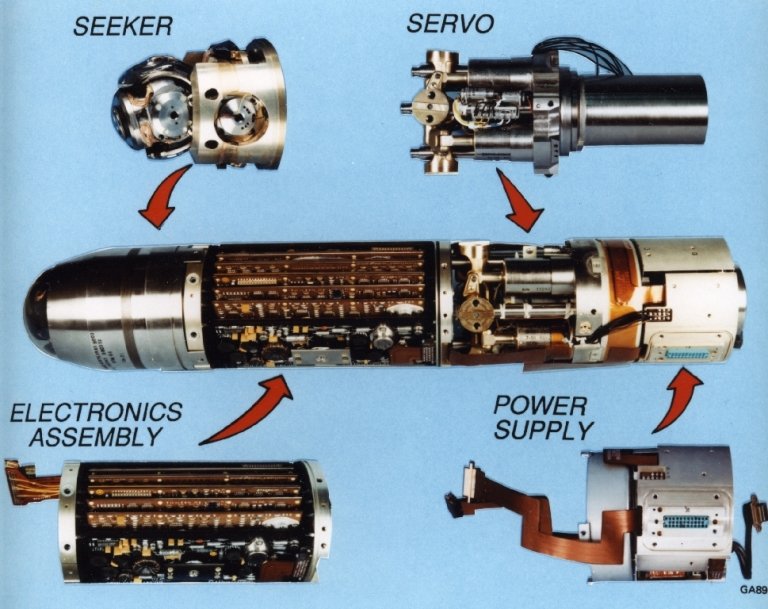 The imaging AIM-9R is the latest naval Sidewinder, using the airframe, fuse and motor of the AIM-9M with a new digital imaging seeker. The new seeker employs a focal plane array imaging device effective to visual wavelengths, mounted on a gimballed stabilised platform. The use of the imaging seeker has provided a vast improvement in target detection range, off boresight angle, rejection of background and ability to selectively aim for vulnerable areas of the target. Imaging seekers are immune to jamming techniques effective against reticle seekers. The AIM-9R provides a major increase in target acquisition range over established subtypes, with much better tracking performance, and the ability to reject both background terrain and clouds. The total field of view of the seeker is much greater, allowing acquisition of off-boresight and manoeuvring targets, while the software provides for intelligent selection of an aimpoint when impacting a target. Loral Aeronutronic, the manufacturer, claim effective counter-countermeasures capability against known and postulated jamming or seduction techniques. At the time of writing (1994) the AIM-9R had successfully flown live firing trials, and was in pilot production, with its long term future unclear due ongoing defence cuts. The Canard-less Sidewinder and the AIM-9X The follow on to the AIM-9M/R in joint service use is the AIM-9X, at this time still very much a development exercise intended for deployment in the late 1990s. (Author's note: this feature article predates the final US decision on the AIM-9X configuration, which is to use an SBRC 128^2 InSb FPA seeker, digital autopilot, fixed forward canards, and steerable tail surfaces and thrust vectoring, retaining the original motor). 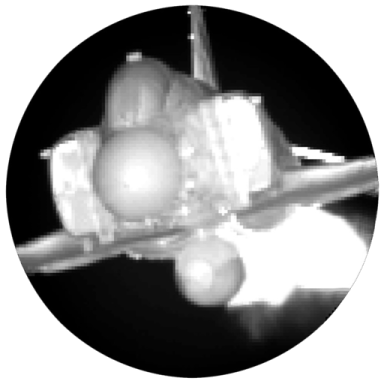 The AIM-9X has yet to be firmly defined, but reports indicate the weapon will probably employ tail control with smaller or no canards. Two airframe geometries will be used, a conventional layout for use by conventional aircraft, and a flat bottomed layout for conformal carriage by stealthy fighters. The flat bottomed airframe is carried upside down and rolls itself upright after launch, a side benefit of this scheme is the potential to use the shape for lifting purposes, if an active roll stabilising system is used. 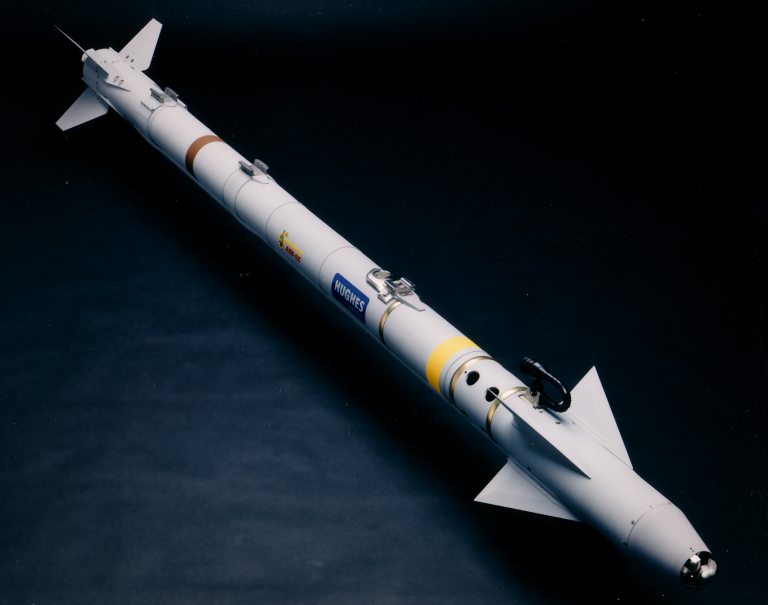 The seeker proposed is a focal plane array, possibly coupled to passive radar homing for use as an ARM or semi-active homing weapon. The former arrangement is used for instance by the GD RAM point defence SAM, interestingly enough itself using a modified AIM-9L/M seeker, and the latest AIM-7 subtype, which also uses an AIM-9L/M seeker. Raytheon, a second source for later model AIM-9s, have under USAF sponsorship expended three years of effort in developing a tail controlled canardless AIM-9 airframe. While most of the details are classified, the weapon uses the standard 5" airframe of the existing AIM-9, with no canards, and a tail control system using a set of small 11" span cruciform movable fins which are arranged in a 60 degree/120 degree pattern, unlike the symmetrical tail of the existing AIM-9. 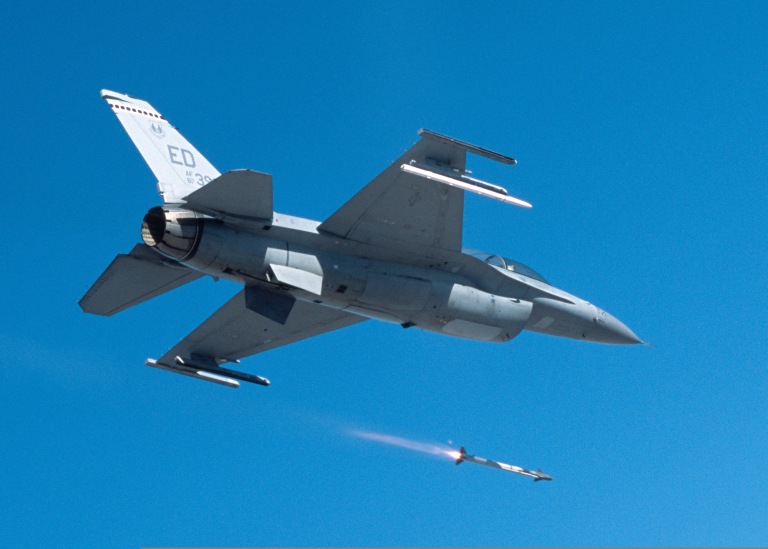 The tail control missile is much faster due lower drag, and has demonstrated in tests higher peak speeds and load factors. A Raytheon designed digital autopilot was fitted, providing for active roll control and reportedly resulting in better stability and manoeuvrability than the established design. Live firing tests carried out by the USAF 3245th Test Wing at Eglin in Florida during the 1990/91 period saw eight launches, of which five were direct hits, one a would be lethal near miss, one a miss and one control system test flight without a target. These weapons employed standard AIM-9M seekers. Much of the USAF's interest in the tail control Sidewinder stems from the ATF program, as the F-22 has small internal weapon bays unable to house the standard Sidewinder. The Naval Weapons Center has also been working on modified AIM-9Ms under the Boa-M program, in which a standard airframe was fitted with smaller AIM-9D canards and a smaller lower drag set of tail surfaces, and a digital autopilot. At least one test firing is known to have been carried out, to the detriment of a QF-86 drone. Both the USAF and USN programs are aimed at size and drag reduction, and higher agility by the use of artificial stability. AIM-9 LATE SUBTYPE COMPARISON TABLE
Cloned Sidewinders - The K-13A/AA-2 Atoll The Atoll traces its genealogy to the early AIM-9B. Numerous stories exist on how the AIM-9 fell into communist hands. One suggests a turncoat German officer drove some friendly GRU agents to a Luftwaffe base and loaded an AIM-9 into a truck, subsequently transporting it across the Iron Curtain. Another more probable story refers to a dogfight between the Nationalist Chinese and Red Chinese over the Formosa straights in the early sixties, during which an AIM-9B embedded itself in the fuselage of a Shenyang F-6 fighter where it failed to detonate. Whichever way it transpired, the communists by the late sixties deployed a missile which was very hard to distinguish from the AIM-9B. Many USAF aircraft in Vietnam fell to sniping tail aspect GCI hits by Atoll firing MiG-21s or F-8s, and the Atoll has since become the most common heatseeking missile in Third World use. Like the AIM-9B, the Atoll requires a skilled user to be effective at its best, and therefore in Third World confrontations the weapon has been of questionable usefulness. Well, at least it looks like a Sidewinder ! The Sidewinder has stood the test of time, and spending 40 years at the cutting edge is a tribute to its original designers, who can be justly proud of their basic design. While its newer derivatives may look different and use different guidance principles, they will all trace their ancestry to the Naval Weapons Centre's original fifties program. The Sidewinder must be acknowledged as the most successful heatseeking missile design of all times. |
||||||||||||||||||||||||||||||||||||||||||||||||||||||||||||||||||||||||||||||||||||||||||||||||||||||||||||||||||||||||||||||||||||||||||||||||||||||||||||||||||||||||||||||||||||||||||||||||||||||||||||||||||||||||||||||||||||||||||||||||||||||||||||
|
||||||||||||||||||||||||||||||||||||||||||||||||||||||||||||||||||||||||||||||||||||||||||||||||||||||||||||||||||||||||||||||||||||||||||||||||||||||||||||||||||||||||||||||||||||||||||||||||||||||||||||||||||||||||||||||||||||||||||||||||||||||||||||
|
|
||||||||||||||||||||||||||||||||||||||||||||||||||||||||||||||||||||||||||||||||||||||||||||||||||||||||||||||||||||||||||||||||||||||||||||||||||||||||||||||||||||||||||||||||||||||||||||||||||||||||||||||||||||||||||||||||||||||||||||||||||||||||||||
|
|||||||||||||
![Sukhoi PAK-FA and Flanker Index Page [Click for more ...]](APA/flanker.png) |
![F-35 Joint Strike Fighter Index Page [Click for more ...]](APA/jsf.png) |
![Weapons Technology Index Page [Click for more ...]](APA/weps.png) |
![News and Media Related Material Index Page [Click for more ...]](APA/media.png) |
||||||||||
![Surface to Air Missile Systems / Integrated Air Defence Systems Index Page [Click for more ...]](APA/sams-iads.png) |
![Ballistic Missiles and Missile Defence Page [Click for more ...]](APA/msls-bmd.png) |
![Air Power and National Military Strategy Index Page [Click for more ...]](APA/strategy.png) |
![Military Aviation Historical Topics Index Page [Click for more ...]](APA/history.png)
|
![Information Warfare / Operations and Electronic Warfare Index Page [Click for more ...]](APA/iw.png) |
![Systems and Basic Technology Index Page [Click for more ...]](APA/technology.png) |
![Related Links Index Page [Click for more ...]](APA/links.png) |
|||||||
![Homepage of Australia's First Online Journal Covering Air Power Issues (ISSN 1832-2433) [Click for more ...]](APA/apa-analyses.png) |
|||||||||||||
| Artwork, graphic design, layout and text © 2004 - 2014 Carlo Kopp; Text © 2004 - 2014 Peter Goon; All rights reserved. Recommended browsers. Contact webmaster. Site navigation hints. Current hot topics. | |||||||||||||
|
Site Update
Status:
$Revision: 1.753 $
Site History: Notices
and
Updates / NLA Pandora Archive
|
|||||||||||||
|
|
Tweet | Follow @APA_Updates | |||||||||||
|
|
|||||||||||||
|
|
|||||||||||||